Introduction
You brought home a rescue cat, dreaming of cozy evenings filled with purrs and head-nudges. Instead, you find yourself sharing your space with a furry enigma, a master of aloofness who seems utterly indifferent to your presence. You adore them, but the lack of obvious affection can be disheartening, leaving you wondering, ‘Does my cat even like me?’ This struggle is common, especially with cats who’ve had difficult pasts. While we can’t force cuddles, understanding subtle feline communication is key. What if technology could offer a little insight? Imagine a cozy bed that not only provides comforting warmth but also gives you a gentle nudge when your elusive companion is secretly purring with contentment. Let’s explore the hidden signs of rescue cat affection and how creating the perfect comfort zone might help you finally feel the love.
Quick Takeaways
- Your rescue cat’s aloofness is often a shield against past trauma, not a rejection of you.
- Learn to spot signs your rescue cat likes you through subtle actions like slow blinks, head-bunting, and quiet companionship.
- A cat’s purr isn’t always happiness; consider the context and their body language to distinguish contentment from anxiety.
- Patience is crucial: let your rescue cat set the pace for interaction and trust-building.
- A secure, predictable environment with warm resting spots helps your cat feel safe enough to express affection.
- Gentle, positive reinforcement builds confidence and strengthens your bond with a shy rescue cat.
- Understanding your cat’s unique, often understated, communication is key to recognizing their growing affection.
Research Summary
This article targets the emotional needs of owners with aloof rescue cats, focusing on identifying subtle signs of feline affection and exploring the concept of a technologically enhanced cat bed designed to detect contentment (purring). Research should cover feline communication, emphasizing behaviors often missed by less experienced owners: slow blinks, head bunting/cheek rubbing (scent marking), tail posture/movement (e.g., the ‘question mark’ tail), kneading, and the significance of proximity or parallel play. It’s crucial to discuss the complexities of purring – cats purr not only when content but also when stressed, injured, or anxious. Explain the difference in context and potential sonic characteristics if available in research. Address common rescue cat behaviors stemming from past trauma, fear, or lack of socialization, including hiding, skittishness, and avoidance. Highlight the importance of patience, creating a safe environment, and positive reinforcement in building trust. Introduce the ‘Self-warming Cat Bed with Integrated Purr Sensor’ as a conceptual tool. Detail the benefits of self-warming beds for cat comfort and security. Explain the idea behind a purr sensor – providing passive feedback on potential moments of contentment without disturbing the cat, thus offering reassurance to the owner. Ground the concept in real feline needs for warmth and security, while positioning the sensor component as a way to bridge the communication gap for owners craving validation.
The Heartbreak of the Indifferent Rescue Cat: Why Validation Matters
Opening your heart and home to a rescue cat is a profoundly rewarding experience, but let’s be honest: it can also be deeply challenging, especially when your new companion seems utterly indifferent. You offer toys, treats, and gentle words, only to be met with a swift retreat under the sofa or a blank stare from across the room. That ache you feel? It’s the sting of unreciprocated affection, the quiet yearning for a sign, any sign, that your efforts are making a difference and that this little creature is starting to feel safe, secure, and maybe even fond of you.
Understanding the Rescue Cat Experience: Fear, Trauma, and Trust
It’s crucial to remember that your rescue cat’s aloofness likely isn’t personal. Many rescued felines come from backgrounds involving neglect, abandonment, unstable environments, or lack of positive human interaction. Their past experiences have taught them that the world can be unpredictable and scary, and humans might be a source of fear rather than comfort. Understanding rescue cat behavior starts with empathy. Hiding, skittishness, and avoidance are often coping mechanisms born from fear and the need to feel secure. They aren’t rejecting you specifically; they’re protecting themselves based on past experiences. Building trust takes time and immense patience. They need to learn, slowly and consistently, that you are a reliable source of safety, food, and gentle care. Imagine spending weeks just sitting quietly in the same room, offering slow blinks (we’ll cover those later!), before your cat finally feels brave enough to stay out in the open when you enter. That progress, however small, is monumental for them.
Why We Crave Connection with Our Feline Companions
Why does their perceived indifference hurt so much? Humans are wired for connection. We adopt pets seeking companionship, warmth, and the simple joy of a shared bond. When we give love and care, we naturally hope for some acknowledgment in return – a purr, a cuddle, a trusting presence. For owners of aloof rescue cats, this desire for validation can feel amplified. You’ve consciously chosen to help an animal in need, pouring emotional energy into their well-being. Seeing signs your rescue cat likes you becomes more than just wanting affection; it feels like confirmation that you’re succeeding in providing them with the healing and security they deserve. This craving is natural. The key insight here is recognizing that your cat also craves connection, but their ability to show it is often hampered by fear. Your journey involves learning their unique, often subtle, language of affection while patiently building trust with a shy cat.
Beyond the Cuddles: Subtle Signs Your Aloof Cat Secretly Likes You
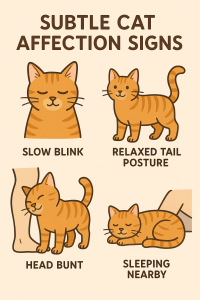
If you’re waiting for your aloof rescue cat to suddenly transform into a lap-loving cuddle monster, you might be missing the quieter, more nuanced ways they’re already showing affection. Many owners wrestle with how to tell if my aloof cat loves me, simply because they’re looking for dog-like demonstrations of devotion. Cats, especially those with cautious temperaments, operate on subtlety. Learning to recognize these understated gestures is key to understanding your bond.
The Slow Blink: A Feline ‘I Love You’
Often referred to as a ‘cat kiss,’ the slow blink is one of the most reliable subtle signs of cat affection. When a cat looks at you, narrows their eyes, and slowly closes and reopens them, it’s a sign of deep trust and relaxation. In the wild, closing one’s eyes in the presence of another creature signals vulnerability. By slow-blinking at you, your cat is essentially saying, “I feel safe and comfortable enough around you to let my guard down.” Try offering a slow blink back! Avoid direct, prolonged stares, which can be perceived as threatening. Instead, meet their gaze softly and slowly blink. You might be surprised to get one in return, a quiet moment of connection across the room.
Head Bunting and Cheek Rubs: Marking You as Their Own
Has your cat ever rubbed their face or forehead against your leg, hand, or even a nearby object? This isn’t just a request for scratches (though they might enjoy those too!). Head bunting and cheek rubbing are ways cats deposit facial pheromones, marking territory and individuals as safe and familiar. When your cat rubs against you, they are essentially saying, “You are part of my trusted group. You smell familiar, you belong.” It’s a possessive gesture, but in the best way possible – an olfactory badge of honor signifying acceptance.
Tail Talk: What That Gentle Twitch Really Means
Cat body language explained often focuses heavily on the tail. While a puffed-up, bristling tail clearly signals fear or aggression, and a thrashing tail indicates irritation, subtle movements can convey affection. A tail held high with a slight quiver or a gentle ‘question mark’ curve at the tip often indicates happiness and a friendly greeting. Even a slow, gentle twitch of the tail tip while they’re resting near you can be one of the signs your rescue cat likes you, suggesting contentment and relaxed awareness of your presence.
The Power of Proximity: Just Being Near You is a Compliment
For a shy or aloof cat, simply choosing to occupy the same space as you is a significant gesture of trust. They might not be on your lap, but are they sleeping on the other end of the sofa? Resting in their bed across the room while you watch TV? Sitting just outside the kitchen while you cook? This parallel play or shared presence, without demanding interaction, demonstrates comfort and acceptance. Consider this scenario: your rescue cat used to bolt every time you entered the living room. Now, they stay put, perhaps even appearing to doze, though you know they’re aware of you. This shift is huge. It signifies that your presence is no longer perceived as a threat, but as a normal, safe part of their environment. This proximity is one of the most powerful, yet often overlooked, signs your rescue cat likes you.
Decoding the Purr: More Than Just Happiness?
Ah, the purr. That gentle rumble is often considered the ultimate sign of feline contentment. When your aloof rescue cat finally settles near you and begins to purr, your heart leaps – finally, they’re happy! But hold on. While purring absolutely can be a sign of bliss, it’s a more complex vocalization than many realize. Understanding the nuances is crucial, especially when interpreting potential signs your rescue cat likes you.
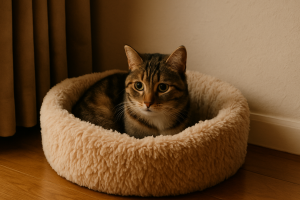
Purrs of Contentment vs. Purrs of Anxiety
Yes, cats definitely purr when they are happy and relaxed. This is the cat purr meaning contentment we all hope for – the deep, rhythmic rumble accompanying kneading, slow blinks, or a relaxed posture in a safe environment, perhaps curled up in a favorite spot (or even, eventually, on your lap!). Do cats purr when happy? Absolutely. However, cats also purr in situations of stress, fear, pain, or even when close to death. Vets frequently report cats purring during examinations, even when injured or ill. It’s theorized that the low-frequency vibrations of purring might be self-soothing or even possess healing properties (promoting bone density and tissue repair). For a rescue cat, purring while hiding, appearing tense, or during a stressful event (like a thunderstorm or the introduction of a new pet) could signal anxiety, not affection. These purrs might sound slightly different – perhaps higher pitched or more strained – but the primary differentiator is context and accompanying body language.
Listening for the Subtle Clues in Your Cat’s Rumble
So, how do you tell the difference? Pay close attention to the entire picture, not just the sound. Interpreting cat sounds requires observing their overall state. Is your cat purring while lounging in a sunbeam, muscles relaxed, eyes half-closed? That’s likely contentment. Are they purring while crouched low, ears flattened, pupils dilated, perhaps in a confined space? That’s more likely stress or fear, potentially indicating a need for feline anxiety solutions or simply more space and quiet. Consider this: Your shy cat starts purring when you approach their safe spot under the bed. Is it happiness at your presence, or anxiety about the proximity? Observe if they lean away or towards your hand, if their body is tense or loose. Over time, you’ll become better attuned to your specific cat’s purr variations and the situations that trigger them. Recognizing that not all purrs are happy doesn’t diminish the joy of a contented rumble; it simply adds depth to your understanding of feline communication and helps you more accurately read the true signs your rescue cat likes you.
Introducing the Comfort Concept: A Bed That Listens
Creating an environment where your aloof rescue cat feels safe and secure is paramount to building trust and observing those coveted signs your rescue cat likes you. While patience and gentle interaction are key, providing physical comforts can significantly accelerate their sense of well-being. A dedicated, cozy resting spot isn’t just a piece of furniture; it’s a sanctuary.
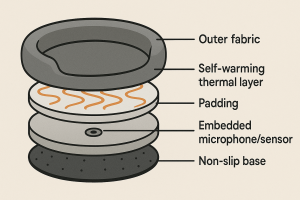
The Importance of Warmth and Security for Cats
Cats are naturally drawn to warmth. It provides comfort, aids relaxation, and mimics the feeling of snuggling with littermates or their mother. For a rescue cat, who may be dealing with underlying anxiety or the stress of adjusting to a new home, a consistently warm spot can be incredibly soothing. Security is equally vital. Cats instinctively seek out enclosed or semi-enclosed spaces where they feel protected from potential threats (even if those threats are just perceived). A good bed provides this sense of enclosure and becomes a reliable cat comfort item, a predictable haven in their world.
How Self-Warming Technology Creates a Haven
The self-warming cat bed benefits lie in their simplicity and effectiveness. These beds utilize special insulating materials or reflective layers that capture and radiate the cat’s own body heat back to them. Unlike electric beds, they require no cords or power, making them inherently safe and energy-efficient. They provide gentle, consistent warmth that enhances relaxation and makes the bed an even more appealing retreat. Imagine your shy cat discovering this perpetually cozy spot in a quiet corner – it becomes their go-to place for stress relief and deep rest, creating a safe space for cats that is truly their own.
Tuning In: How Purr Sensing Could Offer Insight (Hypothetically)
Now, let’s explore an intriguing concept: what if that haven could also offer subtle feedback? This is where the idea of cat purr sensor technology integrated into a self-warming bed comes in. Please note: This is largely a conceptual feature rather than a widely available product currently. The premise is simple: a small, non-intrusive sensor embedded within the bed could detect the vibrations characteristic of a purr. This isn’t about constant surveillance, but about passive feedback for you, the owner craving validation.
Passive Monitoring for Peace of Mind
Imagine glancing over and seeing a tiny, gentle light indicator on the bed, signaling that your cat, nestled deep within their warm sanctuary, is purring. Given what we know about context, you’d still need to observe their overall demeanor, but in the quiet moments when your cat is voluntarily seeking out their safe, warm bed, a detected purr is more likely to be one of contentment. For the owner of an elusive cat, this hypothetical feedback could offer a small, reassuring data point – a whisper of potential happiness – without needing to approach and potentially disturb a cat finally feeling relaxed. It bridges the gap between the cat’s need for undisturbed security and the owner’s yearning for connection, potentially confirming subtle signs your rescue cat likes you even when they keep their distance.
Building Bridges: Tips for Bonding With Your Shy Rescue Cat
Understanding your rescue cat’s subtle cues and providing a comforting environment are huge steps, but active bonding requires patience and the right approach. You can’t force friendship, especially with a cat whose trust has been broken or never fully developed. The goal is to become a source of positive experiences and unwavering security, allowing them to choose connection at their own pace. Implementing effective rescue cat bonding tips is crucial for nurturing this delicate relationship.
Patience is Paramount: Letting Them Set the Pace
This cannot be stressed enough: patience is the cornerstone of building trust with a shy cat. Pushing interaction, cornering them, or forcing cuddles will backfire, reinforcing their fear that humans are unpredictable and overwhelming. Let your cat dictate the terms of engagement. Start by simply being present in the same room without trying to interact directly. Read a book, watch TV quietly, or work on your laptop. Let them observe you being calm and non-threatening. When they do show curiosity – perhaps peeking out from hiding or venturing closer – resist the urge to rush towards them. Stay calm, maybe offer a slow blink (as we discussed earlier!). Celebrate small victories: the first time they eat near you, the first time they stay in the room when you stand up, the first tentative approach. These moments are the foundation upon which trust is built, and recognizing them is part of seeing the early signs your rescue cat likes you.
Positive Reinforcement and Gentle Interaction
Associate your presence with positive things. Offer high-value treats (small pieces of tuna, chicken, or special cat treats) during your quiet time together. Place the treat near you, and gradually decrease the distance as they become braver. Speak in a soft, gentle voice. When they allow you to get closer, avoid reaching over their head, which can seem menacing. Instead, offer your hand, palm down and sideways, below their head level for them to sniff. If they accept, try a gentle scratch under the chin or on the cheek – areas they typically prefer. Keep initial petting sessions brief and always let them retreat if they seem uncomfortable. Interactive play with wand toys can also be a fantastic way to bond, allowing them to engage with you from a distance they find comfortable while satisfying their hunting instincts.
Creating a Predictable and Safe Environment
Consistency is key for anxious cats. Maintain regular feeding schedules and keep their resources (food, water, litter box, resting spots) in consistent, easily accessible locations. Minimize loud noises and sudden movements, especially during the initial adjustment period. Ensure they always have escape routes and safe hiding places they can access easily – creating a safe space for cats involves more than just a bed; it’s about the entire environment feeling secure. A predictable routine helps them understand their world and feel more in control. For example, if your cat knows that mornings involve quiet time, breakfast, and then you leaving for work, it reduces anxiety about the unknown. This stable foundation makes them more receptive to your bonding efforts and more likely to display those subtle, heartwarming signs your rescue cat likes you.
Frequently Asked Questions
Q: Why is my rescue cat so aloof and doesn’t seem to like me?
A: Aloofness in a rescue cat is often a defense mechanism stemming from past trauma or fear, not a reflection of their feelings towards you. They may need more time to feel secure. Look for subtle cues of affection, as their way of showing trust can be understated as they adjust to a new, safe environment.
Q: What are some subtle signs my rescue cat likes me?
A: Rescue cats often show affection in quiet ways. Signs your rescue cat likes you can include slow blinks from across the room, gentle head-bunting against you or furniture nearby, choosing to rest in the same room as you (even if not directly interacting), and soft purring when they feel secure and content in your presence.
Q: If my rescue cat purrs, does that always mean they are happy and like me?
A: Not always. While purring often indicates contentment, cats also purr when they are anxious or in pain. It’s important to consider the context and your cat’s overall body language. A purr accompanied by relaxed posture in a safe spot is a good sign; a purr while hiding or tense might indicate stress.
Q: How can I help my shy rescue cat trust me and show affection?
A: Patience is key when building a bond with a shy rescue cat. Create a predictable, secure environment with comfortable, warm resting places. Let your cat set the pace for interaction, using gentle, positive reinforcement to build their confidence. Avoid forcing interaction, as this can increase their fear.
Q: What is the most important thing to remember when trying to bond with a rescue cat?
A: Understanding that building trust takes time is crucial. Your rescue cat’s past experiences may make them wary. Focus on providing a consistently safe and calm environment, being patient, and learning to recognize their unique and often subtle ways of communicating affection. Your commitment to their well-being is the foundation of your bond.
Conclusion
It’s natural to seek unambiguous signs of affection from your rescue cat, and it can be disheartening when their behavior seems distant or indifferent. However, as this guide has illuminated, an aloof demeanor in a rescued feline is more often a protective response to past fear or trauma than a true reflection of their feelings towards you. Learning to recognize the subtle signs your rescue cat likes you—from a gentle slow blink across the room to the quiet comfort of simply choosing to share the same space—is the first crucial step to understanding their unique language of love and trust.
Remember, building a bond with a shy or traumatized cat is a journey that unfolds at their pace, not yours. Their soft head bunts, contented purrs in a safe space, and eventual willingness to be near you are all significant milestones. Providing a consistently safe, warm, and predictable environment, coupled with patient and gentle interaction, lays the essential foundation for this deepening connection. Don’t be discouraged if progress feels slow; your commitment to understanding their needs and appreciating their quiet ways of showing affection is what truly matters. Continue to observe their subtle signals, be patient in your approach, and consider how you can further enhance their sense of security. The profound bond you’re hoping for is often there, patiently waiting for the right, understanding conditions to fully blossom.
We’d Love Your Feedback
What subtle signs does YOUR rescue cat show to let you know they appreciate you? Share your experiences and tips in the comments below!
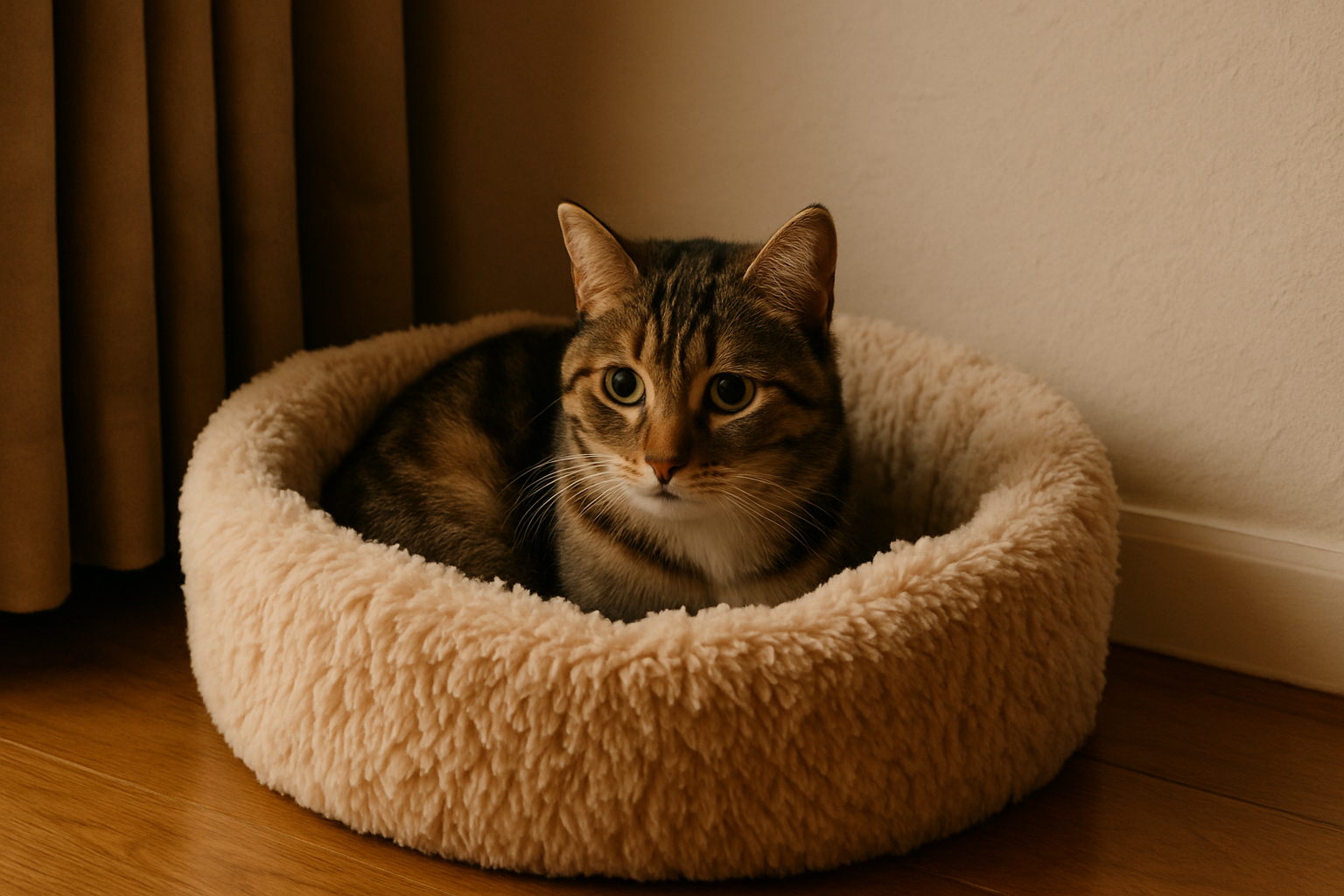
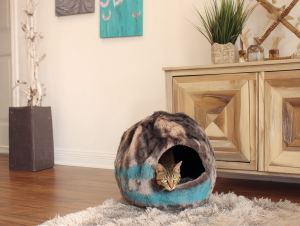
Leave a Reply